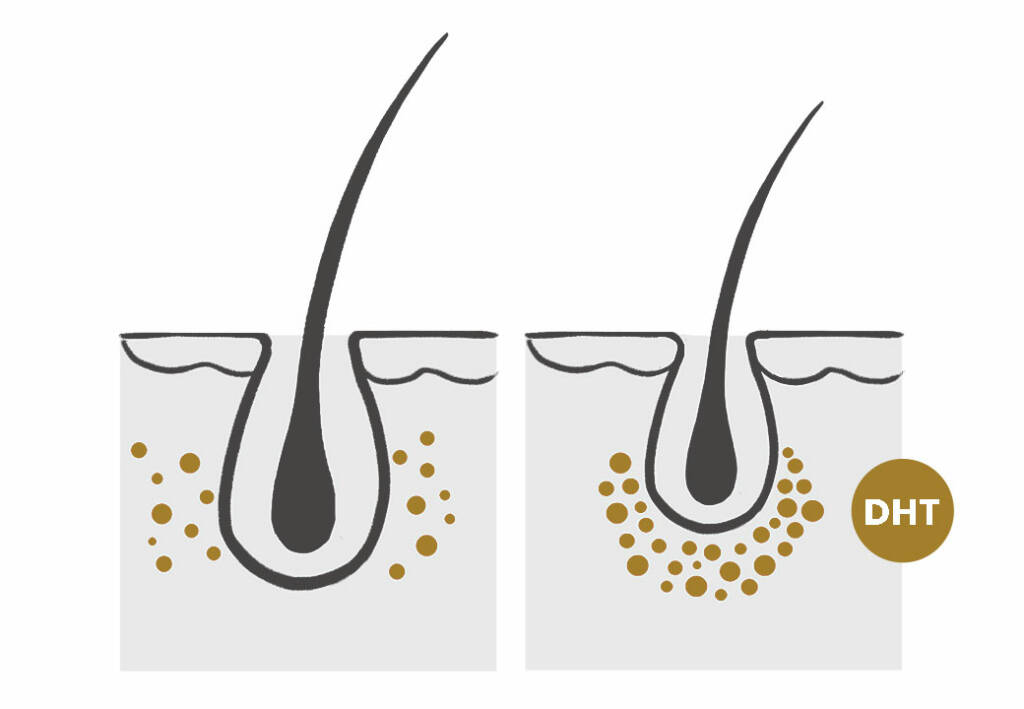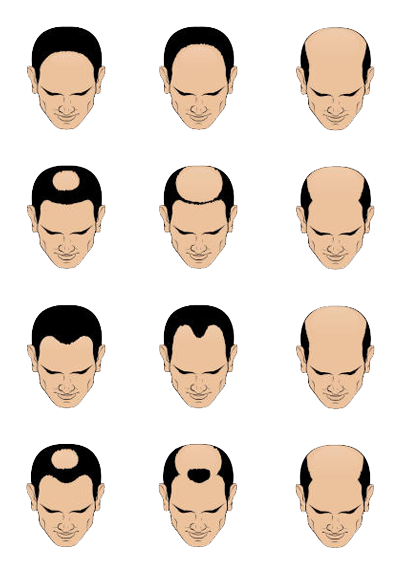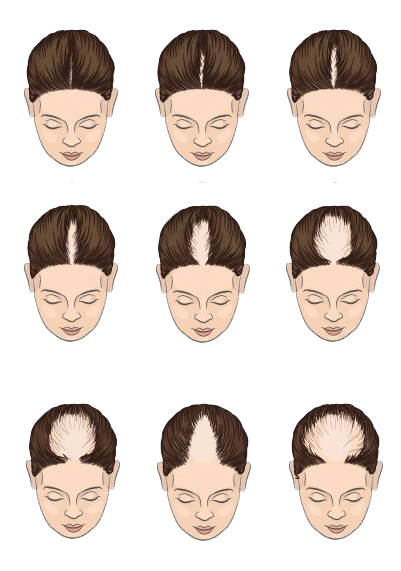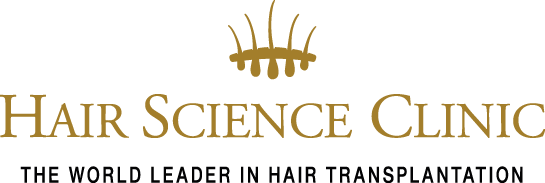HOW DOES HAIR LOSS OCCUR?
Hair loss is caused by many different causes. The most common cause of hair loss in men and women is hereditary hair loss or androgenetic alopecia. This involves a genetically determined sensitivity of the hair follicles to the hormone dihydrotestosterone (DHT), resulting in the hair growth cycle becoming shorter in duration and eventually becoming null, i.e. stopping its growth. In addition to androgenetic alopecia, various hair diseases, hormonal disorders, mental stress and the use of certain drugs are also possible causes of hair loss.

IS HAIR LOSS HEREDITARY?
Hair growth usually lasts two to five years and follows three phases: initially the hairs grow continuously, followed by a period of growth inhibition, after which the hair eventually falls out. Excessive natural hair loss occurs when this growth phase is disrupted. In hereditary alopecia, it is DHT that disrupts the natural flow. Approximately 80% of men who experience hair loss are affected by the hereditary form of hair loss or androgenetic alopecia.
Hair thinning
Usually with hereditary hair loss, the hairs become thinner and thinner. DHT, which binds to hair follicle receptors, causes them to shrink and shortens the hair growth phase. The follicles remain, but shorter and thinner hairs grow, since they do not have time to lengthen and thicken, since their growth stage, as mentioned, is shortened in duration, resulting in the so-called hair thinning. Thus, androgenetic alopecia develops gradually: each hair cycle ends with thinner hair. Eventually, the hair falls out permanently and does not grow back.

Typical clinical picture
In hereditary hair loss or androgenetic alopecia, the hairs on both sides and the back of the head do not fall. Overall, this area is also called the “Hippocratic wreath”. This is because these hairs are not sensitive to the hormone DHT. The hairs above the crown, however, may be sensitive to DHT. This causes (in men in particular) the familiar pattern of hairline retraction at the forehead, greater circular retraction at the temples (“opening” of the temples”) and loss of hair from the vertex, i.e. the centre and top of the skull.
HORSE FOOD
Hereditary alopecia, also called “male pattern baldness”, occurs mainly in men, but also in women. It has a characteristic form of manifestation: in men it is recognised by the thinning of hair on the forehead or temples, a process that can start as early as puberty. In women, androgenetic alopecia usually begins as a thinning of the hair on the frontal hairline and then a uniform receding of this line.
Genetic predisposition
Androgenetic alopecia is largely due to genetic factors. Variations in the DNA that cause it have been discovered in the androgen receptor, but not all the responsible genes have yet been identified. Many genes from both the father and mother affect hair growth, men are more affected by the mother’s family and women by the father’s family.
People who experience it early usually experience baldness as a very unpleasant development, such as in young and middle-aged women in whom baldness is particularly visible. It can also be a very stressful event for men in whom baldness starts at an early age, so it often has a significant impact on quality of life.


Step one: medical diagnosis
A professional is able to easily diagnose hereditary hair loss because it follows a defined pattern. If this is not the case, then hair loss can have many other causes, for example various hair conditions, hormones, cosmetics and various other external factors. Therefore, a comprehensive medical examination and correct diagnosis is always the first step of a treatment program.
FREQUENTLY ASKED QUESTIONS ABOUT HAIR LOSS
Many people, of all ages and both sexes, experience increased hair loss or have varying degrees of thinning (alopecia androgenetic type) or suffer from hair and scalp skin diseases that lead to alteration of the hair shaft or complete atrophy of the hair follicle.
Hair loss is a symptom of a large group of diseases and requires special expertise for its correct diagnosis and effective treatment. Correct and timely diagnosis is of particular importance, as it is often the underlying disease that needs immediate treatment, and not just the symptom of hair loss. In all patients, personal and family history is recorded in detail, health status and possible diseases of other organs that may affect hair growth are discussed.
The examination that is carried out is analytical, in order to identify the various factors that contribute to the development of the problem in each person. In all of them, personal and family history is recorded in detail and the state of health and possible diseases of other organs that may affect the hair growth are discussed.
If necessary, some general biochemical blood tests are carried out to detect possible disorders (anaemia, hormonal abnormalities, etc.) or to detect vitamins, trace elements, amino acids or other factors (e.g. microorganisms such as Candida), which collectively or separately affect the hair.
This is followed by examination of the skin of the head and hair by dermoscopy, trichorizogram, examination of the hair with polarised light or other methods and biopsy when required.
Androgenetic alopecia causes hair thinning, with or without an increase in hair loss. This phenomenon is due to a temporal reduction in the growth or anagen phase of the hair life cycle. This reduction causes a reduction in the size of the hair follicles, which results in shorter and thinner hairs.
Research has shown that there is increased hair loss in autumn compared to other seasons. This increase in hair loss is due to the fact that an increased number of hairs enter the resting or telogen phase of their life cycle in the month of July. This stage takes place about 100 days before the loss of hair. This variation in the rate of hair loss may be due to an evolutionary advantage, so hair only falls out after keeping the scalp warm in winter and after protecting it from the sun during the summer.
This should not cause any concern and is perfectly normal. This white bulb is the part of the hair closest to the root. This means that the hair fell from its base and did not break along its shaft. These hairs are in the resting or telogen phase of the hair cycle and it is normal for them to fall out.
Stress could be one of the factors that cause hair loss. An increase in stress leads to an increase in cortisol production, which negatively affects the function and regulation of the hair cycle. This reaction can lead to hair loss under stressful conditions.
Telogen effluvium is an example of a pathophysiological process that leads to hair loss due to physical or mental stress. In addition, psychological stress can also lead to premature greying of hair.
Male or female alopecia (baldness) is the most common cause of hair loss. This condition is also known as “androgenetic alopecia” because hair loss is caused by two main factors: androgens (male hormones) and genetic predisposition.
Androgen production increases after the onset of puberty. Therefore, the first obvious signs of androgenetic alopecia usually begin in puberty. The most important hormone for the development of this form of hair loss is dihydrotestosterone (DHT), which is a very potent androgen. DHT is produced locally in the hair follicle by converting testosterone. The conversion of testosterone to DHT is regulated by the enzyme 5-alpha-reductase. This enzyme is the target of drugs used to treat hair loss and are called finasteride and dutasteride. Follicles that are predisposed to androgenetic alopecia produce greater amounts of DHT, compared to follicles that are not so predisposed.
Baldness is hereditary, but the exact genes that predispose to baldness are unknown. We know that baldness is polygenic, which means that it is affected by many different genes. It is impossible to know for sure whether a person will develop baldness based on the presence of baldness in certain family members who are related by blood. However, an increase in the number of family members with baldness puts someone at a higher risk. Greater hereditary predisposition puts someone at increased risk of developing severe baldness at a young age.
We could summarise by saying that many genes from both the father and the mother influence hair growth. Men are more influenced, not exclusively, by their mother’s family and women by their father’s family. Therefore, predictors should look, respectively, at male members of the mother’s family for men and female members of the father’s family for women.
Androgenetic alopecia only affects certain areas of the scalp called “androgen-dependent areas”. These are areas that have high levels of androgen hormone receptors in the hair follicle cells and are therefore particularly prone to baldness. These areas are located in the frontal hairline and in the upper part of the head.
Certain areas of the scalp are resistant to androgenetic alopecia and do not lose hair even in cases of severe baldness, namely the occipital region and peripherally on the scalp. These areas are used by hair transplant surgeons to harvest hair follicles.
We do not have the ability to cure androgenetic alopecia, but treatment can stop the progression, promote hair growth and thicken tiny hair follicles.
Hair transplantation can achieve excellent aesthetic results in many of the patients.
A vegetarian or omnivorous diet includes the possibility of insufficient iron intake. Iron deficiency can have a number of negative health effects, including hair. You can take an iron supplement, or eat iron-rich foods to make sure your diet contains sufficient iron. Foods rich in iron are spinach, lentils, quinoa and broccoli.
Lysine supplements can help improve iron absorption. Ask your doctor to assess your body’s iron levels if you think they may be insufficient.
Yes, your thyroid can be a cause of hair loss. Thyroid function (TSH, T3, T4) is always checked in patients suffering from hair loss. Telogen effluvium is for example one of the types of hair loss that can be caused by a thyroid dysfunction.
Hypothyroidism can also lead to dull, brittle hair. Before you have the above tests, tell your doctor if you are taking a biotin supplement.
Biotin may affect the results of these tests and you may be required to stop taking biotin for about 2 days before the day of the test.
This comprehensive examination and the data collected lead to the individualized selection of treatment methods, which include:
- the topical application of minoxidil and other drugs and growth factors (PRP etc.), in densities and combinations prepared specifically for each individual,
- the introduction of these preparations deeper into the hair follicles by iontophoresis, without pain or by local injection,
- autologous mesotherapy with platelet-rich plasma (PRP), which includes growth factors and the concomitant oral administration of trace elements and amino acids that hairs use to grow,
- the administration of oral pharmaceutical substances with local action on hair follicles without side effects,
- the use of lasers and other types of phototherapy, which can be applied even at home, and also,
- hair transplantation by all methods. The two oldest methods are FUT (Follicular Unit Transplantation) and FUE (Follicular Unit Extraction).
During FUT, a strip of skin with hair from the occipital area (donor area) is removed, suitably prepared and implanted in the parietal and frontal areas of the head, while during FUE, a single hair follicle is removed and implanted in the areas with fewer and thinner hairs. However, small scars remain when the hairs are removed from the donor area.
It would be better to know if there is any anaemia, so a complete blood count is necessary. It is also good to know the levels of iron and ferritin, the levels of thyroid hormones and, in women, the levels of certain androgenic hormones.
We have also developed with a specific biopathology laboratory a special urine test, during which we check all the amino acids that are necessary for hair growth, so that if there is a deficiency we can treat it.

FREE DIAGNOSIS
For many forms of baldness, hair transplantation offers a permanent solution. Of all the hair transplant options, HST treatment gives the most beautiful, natural result. A professional diagnosis by a properly trained dermatologist is always the first step when exploring treatment options.
In a free, no-obligation session with one of our dermatologists, we discuss your personal situation and your wishes in detail. Based on this insight, we will give you a tailored advice and a financial offer.

